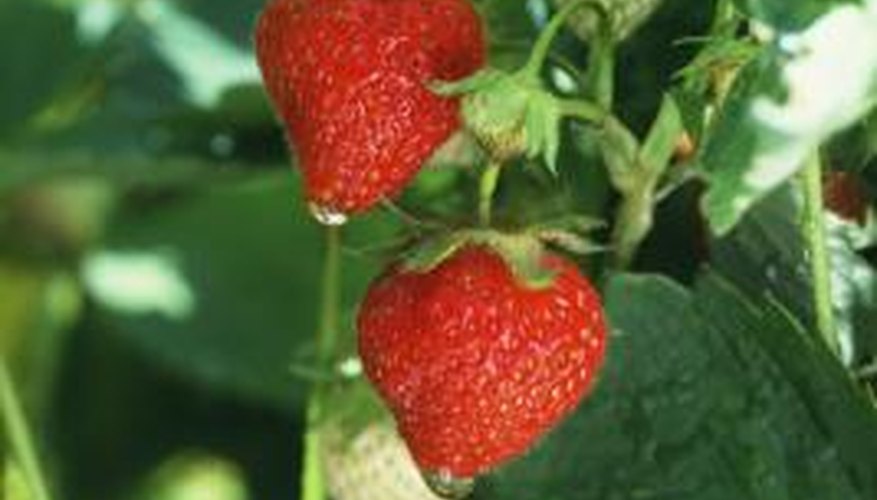Strawberries (Fragaria x ananassa) are among the easiest of fruit plants to grow, but proper site selection and planting remains key to success. Among the issues of proper planting is depth. The crown, or part of the strawberry plant where the roots transition into above-ground leaves, must rest at just the right spot; planting the crown incorrectly leads to diminished plant health or death.
Plant Types
Modern hybrid varieties of strawberries are grouped into one of three categories, based on the timing of fruit production. Junebearers produce one crop of fruits in the lengthening days of spring. Day-neutral strawberries bear in late spring and again in early to mid-fall. Everbearers bloom continually as long as temperatures aren't at freezing any time of year, so multiple crops of berries are possible. Among these three types the plant form may either be bush-like or running. Running strawberries produce stolons, horizontal stems that root atop the soil. New plant crowns form where the stolons root in the soil and create a spreading carpet of plants after time.
- Modern hybrid varieties of strawberries are grouped into one of three categories, based on the timing of fruit production.
- Running strawberries produce stolons, horizontal stems that root atop the soil.
The Crown
Bareroot strawberry plants display the basic root and shoot structure of a strawberry: a matrix of thin wiry roots that gather at the base of a fleshy base called the crown. Leaves grow from the crown's top, while roots grow from its base, which touches the soil. A healthy crown feels firm, not mushy or slimy from rot. Over several years, the crown grows larger, with more roots and stem buds, creating a plumper strawberry plant.
- Bareroot strawberry plants display the basic root and shoot structure of a strawberry: a matrix of thin wiry roots that gather at the base of a fleshy base called the crown.
Planting Strawberries
The crown becomes central focus when planting strawberry plants in the garden. Proper planting depth determines if and how well plants establish and grow over the ensuing months of spring and summer. The base of the plant crown should remain exactly at the soil surface after planting. If planted too deeply, moisture causes the crown to rot and leaves fail to develop properly. Planting the crown too shallowly so roots are exposed to air leads to the strawberry plant dying from dry, dead root tissues.
- The crown becomes central focus when planting strawberry plants in the garden.
- Planting the crown too shallowly so roots are exposed to air leads to the strawberry plant dying from dry, dead root tissues.
Runners
Stolons that run across the moist soil surface drop roots and create new plant crowns just above the soil surface. Everbearer strawberries don't produce many stolons compared to other types. Ambitious gardeners may sever the stolons once a small plantlet develops and transplant it to another area of the strawberry patch. Runners produce crowns that are genetic clones of the mother plant and yield fruits with the same characteristics, including size and flavour.
- Stolons that run across the moist soil surface drop roots and create new plant crowns just above the soil surface.
- Ambitious gardeners may sever the stolons once a small plantlet develops and transplant it to another area of the strawberry patch.
